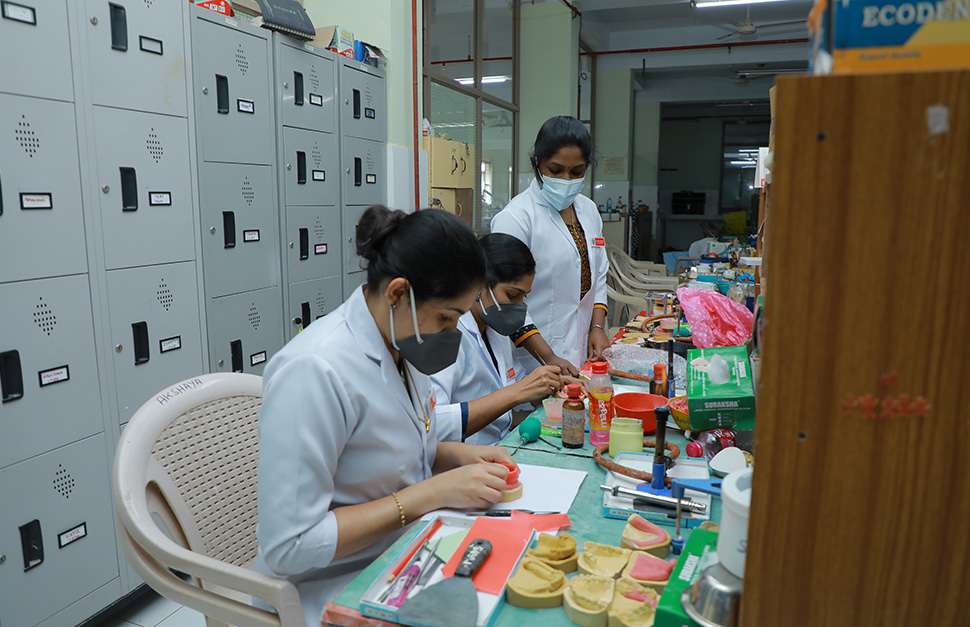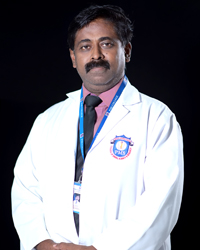
The speciality of prosthodontics is the amalgamation of art and engineering with dental medicine. This most happening speciality of dentistry deals with rehabilitation and maintenance of oral function, while ensuring comfort, appearance, and health of the patients. This is a branch that has exploited the scope of modern digitisation and artificial intelligence to the maximum.
The department offers comprehensive training for the aspiring dentists. The Undergraduate program includes theory lectures and clinical training. Beginning with pre-clinical practical training in complete denture and partial denture construction on stone models in the first two years, followed by treatment procedures carried out on actual patients under the able guidance of the teachers, the students are trained to treat completely edentulous and partially edentulous patients with removable prosthesis. Various activities are also included in the curriculum like fun with dental materials, teeth setting competition etc to make learning more enjoyable.
The postgraduate programme is designed to prepare students for a career in teaching and research and also for advanced training in the rehabilitation of completely edentulous, partially edentulous patients and patient requiring maxillofacial prosthesis. In addition, the academic schedule includes seminars, journal club presentations, case presentations, and a library dissertation. The students also participate actively in national and international specialty conferences by presenting scientific papers, table clinics and scientific posters.
Implantology Program: Integrated Centre for Oral Implantology with Hands on Exposure to various Implantology protocols, functions in sync with the department of Prosthodontics, Periodontics and the OMFS department, ensuring a multidisciplinary approach, to cater to patients needing Implant Prosthodontics.
A well-equipped departmental lab with separate casting lab, ceramic lab and individual work stations for post graduates and technicians. The laboratory is equipped with state-of-the-art equipment like Vita ceramic furnace, induction casting machine, to name a few. The laboratory facilitates the fabrication of a variety of dental prostheses of high quality to serve the patients.
The UK regulator for dental professionals, General Dental Council (GDC), has defined prosthodontics as “the replacement of missing teeth and the associated soft and hard tissues by prostheses (crowns, bridges, dentures) which may be fixed or removable, or may be supported and retained by implants”.
This specialized training enables prosthodontists to perform the more complex procedures required to restore and replace teeth and maintain oral health effectively. In addition to dealing with complex dental cases requiring bonding, bridges or dentures, and dental implants, and surgeries involving bone and tissue, prosthodontics also trains them in areas dealing with geriatric dental care, oral restoration for cleft palates and cleft chin, reconstruction after oral cancer, maxillofacial procedures, and treatment of snoring and sleep disorders like sleep apnoea.
Implant prosthodontics also involves the use of dental implants like crowns, bridges and overdentures but it is done in combination with the artistry and expertise that comes with prosthetic dentistry. This results in aesthetically pleasing replacements for even complex dental issues that are functional and durable.
Training in prosthodontics also involves teaching the aspiring prosthodontists the skills required to help patients maintain the prosthodontics once they have been put into place. The success and durability of prosthodontic restorations is primarily dependent on prosthodontic maintenance skills. In addition to good oral hygiene, regular professional cleaning around the restorations and periodic assessment of the prostheses for wear and tear, fractures or other issues is a requisite to ensuring the longevity of the prostheses.
Prosthodontics And Crown & Bridge
Prosthodontics is the branch of dentistry that amalgamates art and engineering with dental medicine. This most promising specialty of dentistry deals with rehabilitation and maintenance of oral function, while ensuring the comfort, appearance, and health of the patients. This is a branch that has exploited the scope of modern digitization and artificial intelligence to the maximum.
Types of Prosthodontic Treatments
Based on the different parts of the mouth or jaw that are treated, there are broadly four branches in prosthodontics – Fixed Prosthodontics, Removable Prosthodontics, Implant Prosthodontics, and Maxillofacial Prosthodontics.
Fixed Prosthodontics – Oral restoration treatment using prosthodontic appliances that are fixed into the patient’s mouth is known as fixed prosthodontics. Dental Crowns, Dental Bridges, Inlays, and Veneers are common examples of fixed prostheses.
Removable Prosthodontics – Complete or partial dentures that replace a missing tooth/teeth in a patient’s mouth and can be removed and cleaned easily are known as removable prosthodontic appliances.
Maxillofacial Prosthodontics – Highly specialized treatment procedures related to cleft lip and palate of the mouth, pinna (the external part of the ear), nose, eye, and chin come under maxillofacial prosthodontics. Prostheses such as Speech Bulbs, Palatal Lifts, Obturators, and Palatal Augmentation Devices are used in the treatment.
Implant Prosthodontics – When a patient has issues with missing tooth roots, he/she will need dental implants which are sturdy, rigid screw / cylinder-like structures that provide support and durability to a dental bridge, denture, or maxillofacial prosthesis.
Benefits of Prosthodontic Care
Restoration of teeth to their old form, function, and appearance is the main purpose of prosthodontics. This goes beyond cosmetic beautification of smiles, it offers lasting advantages for the patient’s oral health as well as overall wellbeing.
- Aesthetic restoration after an injury or accident trauma
- Functional restoration for optimising bite, chewing and digestion, speech issues, and sleep disorders
- Conservation of tissues damaged due to dental decay.
- Oral reconstruction after chronic illnesses like cancer
Advances in Prosthodontic Technology
The most significant advancement in prosthodontics, and in dentistry in general, has to be the integration of digital technology into dental practice. The use of CAD / CAM technology and 3D printing have revolutionized the design and fabrication of dental prostheses, improved the quality and precision of the appliances, and reduced the turnaround time for treatment.
There have also been improvements in the prosthodontic materials being used in dental restorations. Biomimetic materials that are designed to mimic the natural composition of tooth enamel and dentin enable prosthodontists to provide restorations that look like the patient’s natural teeth and are functionally compatible. High-performance prostheses made of advanced polymers and reinforced ceramic composites have also gained popularity due to their strength and durability, and are being used in bridges and crowns for posterior teeth where high stress resistance is required.

